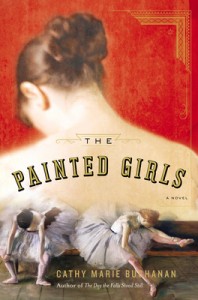 LA BELLE EPOQUE – PARIS’ BEAUTIFUL ERA: It’s an education to read Canadian author Cathy Marie Buchanan’s remarkable 2nd novel, set in Paris during its “golden years” (before WWI), this story spanning 1878-1895. Feast on unfamiliar language that draws you into the graceful, ambitious, and grueling world of the ballet arts at the famed Opera House where classical ballet started – where dancers were called “petit rats” because their training was so demanding – a world of glissades and entrechats and quadrilles and coryphées, of sujets, étoiles, fouettés en tournant. “Our style is refined. You are French,” they are instructed. The atmospheric prose is also filled with 19th century references to looking glasses and gas lamps, velvet divans, corsairs, pomades, coquettes. This is historical fiction during France’s Third Republic, when the country enjoyed peace and prosperity, when the arts exploded, supported by the wealthy. But there was also a darker “demi-monde,” an underclass of poverty, brothels, and criminals, when New Caledonia, an island in the South Pacific, was a thriving penal colony. The Painted Girls is about wanting to be a “real ballet girl on the Opera stage” alongside a hidden underworld – an intriguing story about ambition and its dangers, about hope and hopelessness.
LA BELLE EPOQUE – PARIS’ BEAUTIFUL ERA: It’s an education to read Canadian author Cathy Marie Buchanan’s remarkable 2nd novel, set in Paris during its “golden years” (before WWI), this story spanning 1878-1895. Feast on unfamiliar language that draws you into the graceful, ambitious, and grueling world of the ballet arts at the famed Opera House where classical ballet started – where dancers were called “petit rats” because their training was so demanding – a world of glissades and entrechats and quadrilles and coryphées, of sujets, étoiles, fouettés en tournant. “Our style is refined. You are French,” they are instructed. The atmospheric prose is also filled with 19th century references to looking glasses and gas lamps, velvet divans, corsairs, pomades, coquettes. This is historical fiction during France’s Third Republic, when the country enjoyed peace and prosperity, when the arts exploded, supported by the wealthy. But there was also a darker “demi-monde,” an underclass of poverty, brothels, and criminals, when New Caledonia, an island in the South Pacific, was a thriving penal colony. The Painted Girls is about wanting to be a “real ballet girl on the Opera stage” alongside a hidden underworld – an intriguing story about ambition and its dangers, about hope and hopelessness.
It’s a masterfully invented “story of a heart and body” – mostly Marie van Goethem’s story. The author has imagined, using a long list of historical resources, the life of the true subject of Edward Degas’ famous statuette, Little Dancer Aged Fourteen; about whom little is apparently known. Buchanan’s creation is a scrawny, avid reader of French newspapers, 14-year old Marie, whose father dies when the book opens, her Maman is a laundress addicted to absinthe, and she lives with her two sisters in dire poverty in a lodging room in Montmartre. Marie feels she is ugly but she’s talented and a hard worker. She sees dancing as “grace” and a way out of poverty. She is protected by her 18-year old sister, Antoinette, who we’re introduced to when she’s been kicked out of the ballet and soon meets the dubious Emile Amadie, an actor in Emile Zola’s controversial play, L’Assommoir.
We empathize with Antoinette’s descent into darkness, as all she really wants is to be “adored.” We admire her devotion to Marie, care about their struggles. The novel alternates between these two sister’s voices. Charlotte, the third and youngest sister, remains angelic, destined, and sweetly innocent. As Marie and Antoinette’s choices and differences play out through the alternating chapters and years, Antoinette wonders in her distinguishable poor grammar: “What was it made that girl want so much? She craved the stage? But why? And was there something lacking in me that I was over it in a week …?”
When you finish this memorable novel, you may conclude it’s an uplifting “tale of working hard and getting what you want most” or a sad tale of “being downtrodden and staying that way.” Perhaps both?
After reading The Painted Girls, I viewed 16 of Degas’ drawings, paintings, and sculpture on Buchanan’s website, as she encourages: www.cathymariebuchanan.com/art. When you scroll over each of the images, you’ll find the prose that corresponds in the book to those works. Fascinating. This is a novel you may want to read slowly, an ambitious exploration of social class, longing, and exploitation when groundbreaking arts flourished in Paris in the late nineteenth-century. You might also want to click to see these stunning photos of the Paris Opera House.
Since this novel was thoughtful and thought-provoking, I’d like to read Cathy Marie Buchanan’s debut novel, The Day The Falls Stood Still. She’s from Niagara Falls, Ontario, so I’m interested in how she crafts a story based on what she already knows, given her impressive imagination with historical French fiction.
Happy Reading, Lorraine
Thank you for this. It’s easy to see the thought and care you took in crafting it. I especially like the way you incorporated quotes from the book into your review: “It’s a masterfully invented ‘story of a heart and body’ – mostly Marie van Goethem’s story.” Thank you for reading and helping spread the word.
A beautifully written review, Lorraine. I’m going to put a hold on this book right away! I’m especially eager to read it, since I love Degas so much.